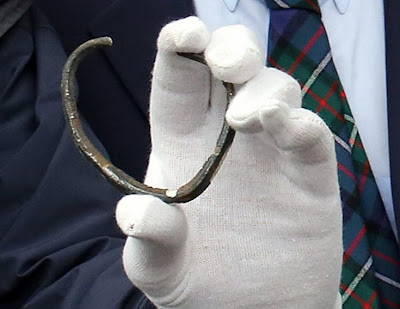 |
| The ring was found close to the remains of a medieval church [Credit: BBC] |
Almost 18 months ago, Mr Taylor noticed the strangely-shaped object lying on a stone in his brother-in-law's freshly ploughed field near Kircubbin on the Ards peninsula.
Mr Taylor, who was helping Andrew Coulter remove stones from the field at the Inishargy Road, said he was glad he did not listen to his wife Lynda. Instead he gave the ring a wash and contacted his nearest museum.
"She thought it was a bull ring and said 'throw that in the bin'," he laughed after the ruling at a treasure trove inquest hearing at Belfast coroner's court. "I just knew by the shape of it, it was something."
The artefact is thought to date from some time between the 10th and 12th Centuries.
Currency
Such finds are not usually made in Ireland and it is thought the ring may have originated in Shetland or the Orkney isles which were ruled by Vikings at that time. Vikings often used jewellery as a form of currency before they adopted coins.
According to University College Cork archaeologist John Sheehan the ring was found close to the remains of a medieval church.
Mr Sheehan told the coroner's court that religious sites were often used as a storage place for valuable items. He suggested the ring may have been stolen from Viking settlers by the native Irish.
"Maybe it fell into Irish hands and as a result of that ended up deposited for safe-keeping at a church site but then got lost," he said.
Mr Taylor was also thankful that he decided to help out his brother-in-law on the evening of the find in April last year.
"The night I went to help Andy lift the stones, he says 'nobody ever helps me lift stones'," he said.
The 45 g (1.6oz) ring will now go for valuation by experts at the UK Treasure Valuation Committee.

No comments:
Post a Comment